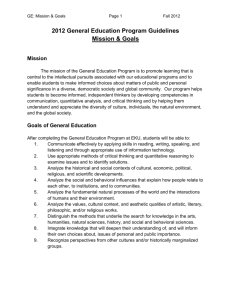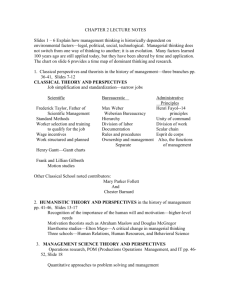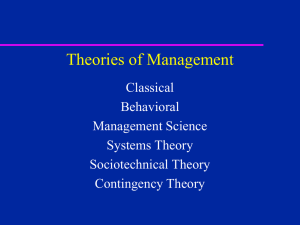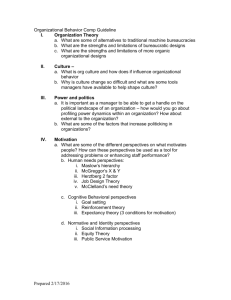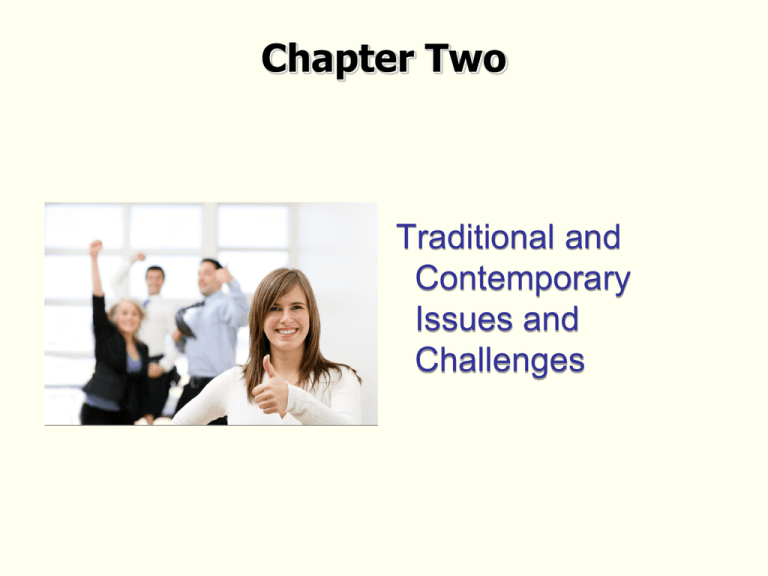
Chapter Two
Traditional and
Contemporary
Issues and
Challenges
Learning Objectives
After studying this chapter, you should be able to:
1.
Summarize and evaluate the classical perspective on
management, including scientific and administrative management,
and note its relevance to contemporary managers.
2.
Summarize and evaluate the behavioral perspective on
management, including the Hawthorne studies, human relations
movement, and organizational behavior, and note its relevance to
contemporary managers.
3.
Summarize and evaluate the quantitative perspective on
management, including management science and operations
management, and note its relevance to contemporary managers.
4.
Discuss the systems and contingency approaches to
management and explain their potential for integrating the other
areas of management.
Case
You are a management
consultant and is
required to recommend
ways to increase the low
productivity of Bapco’s
workers at oil processing
department.
How to increase productivity?
Find ways to
increase the
efficiency of the
individual
workers and the
whole
orgnisation
Find ways to
understand
individuals
behavior,
groups and
teams, to
motivate them
and effectively
lead them
Find ways to
improve the
operation,
decision making
and resource
allocation
How to increase productivity?
Find ways to
increase the
efficiency of the
individual
workers and the
whole
orgnisation
Classical
Find ways to
understand
individuals
behavior,
groups and
teams, to
motivate them
and effectively
lead them
Find ways to
improve the
operation,
decision making
and resource
allocation
Behavioral
Quantitative
Management Perspective
Classical
Behavioral
Management
Perspectives
Quantitative
Management
Perspectives
Management
Perspectives
Universal Mgt Perspective: One best way
Management Perspectives
Classical
Management
Perspectives
Methods for
enhancing
efficiency and
facilitating planning,
organizing, and
controlling
Behavioral
Management
Perspectives
Insights for motivating performance
and understanding
individual behavior,
groups and teams,
and leadership
Quantitative
Management
Perspectives
Techniques for
improving decision
making, resource
allocation, and
operations
An Integrative
Framework of
Management
Perspectives
Universal
Management
Perspectives
Systems Approach
• Recognition of internal
interdependencies
• Recognition of
environmental influences
Classical
Management
Perspectives
Methods for
enhancing
efficiency and
facilitating planning,
organizing, and
controlling
Contingency Perspective
• Recognition of the situational
nature of management
• Response to particular
characteristics of situation
Behavioral
Management
Perspectives
Insights for motivating performance
and understanding
individual behavior,
groups and teams,
and leadership
Quantitative
Management
Perspectives
Techniques for
improving decision
making, resource
allocation, and
operations
Effective and efficient management
THE MANAGEMENT PERSPECTIVE
THE UNIVERSAL MANAGEMENT PERSPECTIVE
Classical
Scientific Management
Administrative Management
Behavioral
Hawthorn Study
The Human Relations Movement
Organizational Behavior
Quantitative
Management Science
Operation Management
INTEGRATING PERSPECTIVES FOR MANAGERS
System Approach
Contingency Theory
Classical Management Branches
• Scientific Management
Increasing the efficiency
of the individual worker
• Administrative
Management
Focuses on managing the
total organization
Scientific Management Perspective
Fredrick Taylor
Henry Gantt
Frank and Lillian Gilbreth
Harrington Emerson
Fredrick Taylor
• Soldiering Employees deliberately working at a
slow pace
To increase the efficiency of the individual
worker
– Redesigned Jobs: Observe, Select, Train , Implement PPS
– Piecework pay system – Any work that is produced above
the target level of output will be paid by the piece
– Rest periods
Frank and Lillian Gilbreth
(Husband and Wife) Industrial engineers
Frank
Bricklaying
Standardization of Materials
Procedures to perform the job
Result- Increase output by 200%
Lillian
Industrial psychology + Personnel mgt
Both
“Cheaper by the Dozen”
Henry Gantt
Developed other
techniques,
including the Gantt
chart, to improve
working efficiency
through
planning/scheduling
Henry Gantt – A scheduling Devise
Week 1
Completed
Planned
1. Design
2. Purchase Parts
3. Fabricate Bodies
4. Fabricate Frames
5. Build Drive Trains
6. Assemble Carts
7. Test Carts
1
2
3
Week 2
4
Week 3
Week 4
5 8 9 10 11 12 15 16 17 18 19 22 23 24 25 26
Harrington Emerson
• Consultant -1910
• Interstate Commerce
Commission
• By using Scientific management
railroads could save $1 million a
day
• Advocated job specialization in
both managerial and operating
jobs.
How would the scientific mgt scholars improve
the productivity of workers at Bapco?
Fredrick Taylor
Henry Gantt
Frank and Lillian Gilbreth
Harrington Emerson
How would the following scientific management scholars
improve the productivity of workers at Bapco?
Fredrick Taylor
Henry Gantt
Frank and
Lillian Gilbreth
Harrington
Emerson
Classical Management Branches
• Scientific Management
Increasing the efficiency of
the individual worker
• Administrative
Management
Focuses on managing the
total organization
Administrative Management
• Focuses on managing the total
organization
Henry Fayol,
Max Weber
Chester Barnard
Lyndall Urwick
Administrative Management Perspective
Henry Fayol
Chester Bernard
Max Weber
Lyndal Urwick
Henri Fayol
•French industrialist
•Systematize the
practice of
management
•
•Identified managerial
functions
Max Weber
• German Sociologist
• Bureaucratic
Structure
– guidelines for
structuring the
organization in the
most efficient way
Chester Barnard
• ‘The Functions of the
Executive’- book
• Subordinates Acceptance of
Authority
= f (understands it;
able to comply with it;
views it as appropriate)
Lyndall Urwick
• Scientific Mgt + Administrative
Mgt
• Advanced our thinking managerial
functions and managerial
effectiveness
• No specific new contributions but
rather the integration of the
previous theories
Administrative Management Perspective
Henry
Fayol
Max
Weber
Chester
Bernard
Lyndal
Urwick
Contributions
Limitations
+ Foundations
- Is it appropriate
now
+ Identified
processes, skills,
functions
- Is it universal
+ mgt valid subject
of scientific inquiry
- Is it right to treat
employees as tools
The Behavioral Management Perspective
Placed emphasis on
individual attitudes
and behaviors and
on group
processes and
recognized the
importance of
behavioral
processes in the
work place.
Branches of Behavioral Mgt Perspective
• Hawthorne Studies
• The Human Relations
Movement
• Organizational
Behavior
Hawthorn Studies
• Years 1927-1932
• Founder
Elton Mayo & Colleagues
• Place Western Electric
• Lighting Experiment
• Piecework Incentive Pay
• Interview program
Hawthorn Studies - Findings
Importance of Human
Element
• Recognition - Feeling
important
• Belonging to a group –
relationships
The Human Relations Movement
• Proposed that workers
respond primarily to the
social context of the
workplace, including
social conditioning,
group norms, and
interpersonal dynamics
– Maslow’s Hierarchy
of Need
– McGregor Theory X &
Y
Maslow’s Hierarchy of Needs
Self-actualization needs
Esteem needs
Social needs
Safety needs
Physiological needs
Behavioral Theory on How Employees Behave Toward Work - pessimistic
Employees
– dislike work.
– are irresponsible.
– lack ambition.
– resist change.
Another Theory on How Employees Behave – Optimistic
Employees are
– willing to work.
– self directed.
– accept responsibility.
– creative.
– self-controlled
Organizational Behavior
• Psychology, sociology, anthropology, economics,
and medicine.
• Individual + Group + organizational processes
• Stress, motivation, group dynamics, interpersonal
conflict, job satisfaction, organizational politics
Contributions
+ Challenged
thinking
+ Insights into
- motivation
- group dynamics
- interpersonal
processes in
Limitations
- Prediction of
human behavior
- Adaptation
- Communication
The Quantitative Management Perspective
Decision making,
mathematical models,
use of computers
– Management
Science
– Operations
Management
The Quantitative Management Perspective
•Management Science
– Focuses specifically on the
development of mathematical
models (simplified representation
of a system, process, or a
relationship)
•Operations Management
– Applies quantitative techniques
(mgt science) to management to
help the organization produces
goods and services more
efficiently and to run the
operation
• Inventory Mgt
• Linear Programming
Mgt Science and Operations Management
Mgt Science and Operations Management
Mgt Science and Operations Management
• BEQ = FC / (TC-VC)
• Development mathematical equation
• Application of Mathematical Equation – using BEQ to determine
the minimum quantity that must be produced to cover all the
costs
Contributions
• Techniques to assist
in decision making
•
Awareness of
complex
organizational
processes
• Planning and
controlling
Limitations
- Not fully able to
predict human
behavior
- Costs vs. other
skills
- Assumptions
Are the three
management
perspectives
contradictory or
complimentary
Integrating Perspectives for Managers
• A complete understanding of management requires
an appreciation of, classical, behavioral, and
quantitative approaches.
– The systems perspectives and
– Contingency perspectives
An Integrative Framework of
Management Perspectives
Systems Approach
• Recognition
of internal
interdependencies
• Recognition of
environmental influences
Classical
Management
Perspectives
Methods for
enhancing
efficiency and
facilitating planning,
organizing, and
controlling
Contingency Perspective
• Recognition
of the situational
nature of management
• Response to particular
characteristics of situation
Behavioral
Management
Perspectives
Insights for motivating performance
and understanding
individual behavior,
groups and teams,
and leadership
Effective and efficient management
Copyright © Houghton Mifflin Company. All rights reserved.
Quantitative
Management
Perspectives
Techniques for
improving decision
making, resource
allocation, and
operations
The Systems Perspective
of Organizations
Inputs from
the
environment:
material inputs,
human inputs,
financial inputs, and
information inputs.
Transform
ation
Process:
technology,
operating
systems,
administrative
systems, and
control systems
Feedback
Outputs
into
the environment:
products/services,
profits/losses,
employee behaviors,
and information
outputs
Match the example with the appropriate concept that illustrates it:
Open system, Closed System, Subsystem, Synergy, Entropy
• Hewlett-Packard and Compaq is merger is based on the notion that
working together in a cooperative and coordinated fashion will benefit
the two companies more than working alone.
• IN ALBA, a decision that was taken by the production department to
lower he quality of the materials used will effect the Finance and
marketing departments. There is an autonomy for each department, but
decisions of one department affects the others. This is because the
departments are -------------.
• One of the reasons attributed to the failure of Bahrain Cinema Company
in the 80s was that they ignore the effect of the of VCRs (videos) on
their demand.
• UOB monitors the quality of its’ services by requiring students to
evaluate their instructors and the subject.
• The main reason attributed to ENRON’s failure is overlooking a simple
process of checking the money used versus the quota of their brokers.
The System Perspective - Concepts
• Open system
• Closed systems
• Subsystem
• Synergy
• Entropy
Open System
An
organizational
system that
interacts with
its
environment
Closed System
An organizational
system that
doesn’t interacts
with its
environment
Subsystem
A system
within
another
broader
system
Synergy
Synergy two or
more
subsystems
working together
may often be
more successful
then working
alone
Entropy
A normal
process
leading to
system
decline
Contingency vs. Universals
• Universal perspective:
tempting to identify one
best way.
• Contingency perspective:
depending on
elements in that situation.
Figure 2.5: The Emergence of Modern
Management Perspectives
Copyright © Houghton Mifflin Company. All rights reserved.
Contemporary Mgt Challenges
Labor shortage
Management of diversified workforce
Values, goals and beliefs of the new generation workforce
Management of change
Organizational Structure
Information Technology
Globalization and its effect
Ethics and social responsibility
Quality & its importance for competitiveness
Service Economy
• Labor Shortage
– Advancement in technology
– Demand for technology-related employees (salaries)
– Effect on Lower-skills jobs
• Management of Diversified Workforce
– Differences among people
– Internationalization factor
– Difficulty in management
• Values, Goals and Beliefs of the New Generation
Workforce
–
–
–
–
Less devoted to long-term career prospects
Less to Conformity and uniformity
How to attract and motivate
Flexibility
• Management of Change
– Rapid and constant environment change
– Change is an opportunity
• New Technology
–
–
–
–
–
Internet, e-business, e-government, Information technology
Investment in technology
Employee-privacy
Decision-making quality
Physical or virtual offices
• Organization Structure
– Weber’s bureaucratic structure
– Now, Flat structure
• Globalization
– Role of government in business
– Behavioral processes vary widely
– Values and beliefs of Bahraini vs. Japanese employee
• Ethics and Social Responsibility
– Business scandals
– Increased contributions to social issues
• Quality
– Used as a base for competition
– Quality and productivity
• Service Economy
– Traditionally, manufacturer
– Now, half of GDP of USA from service industries

